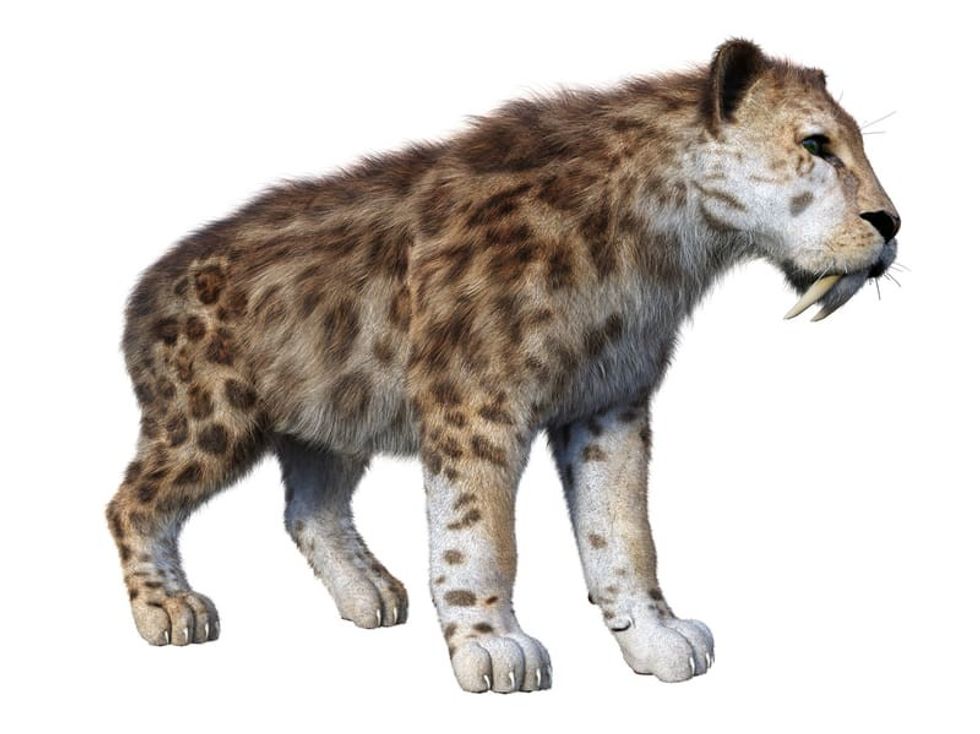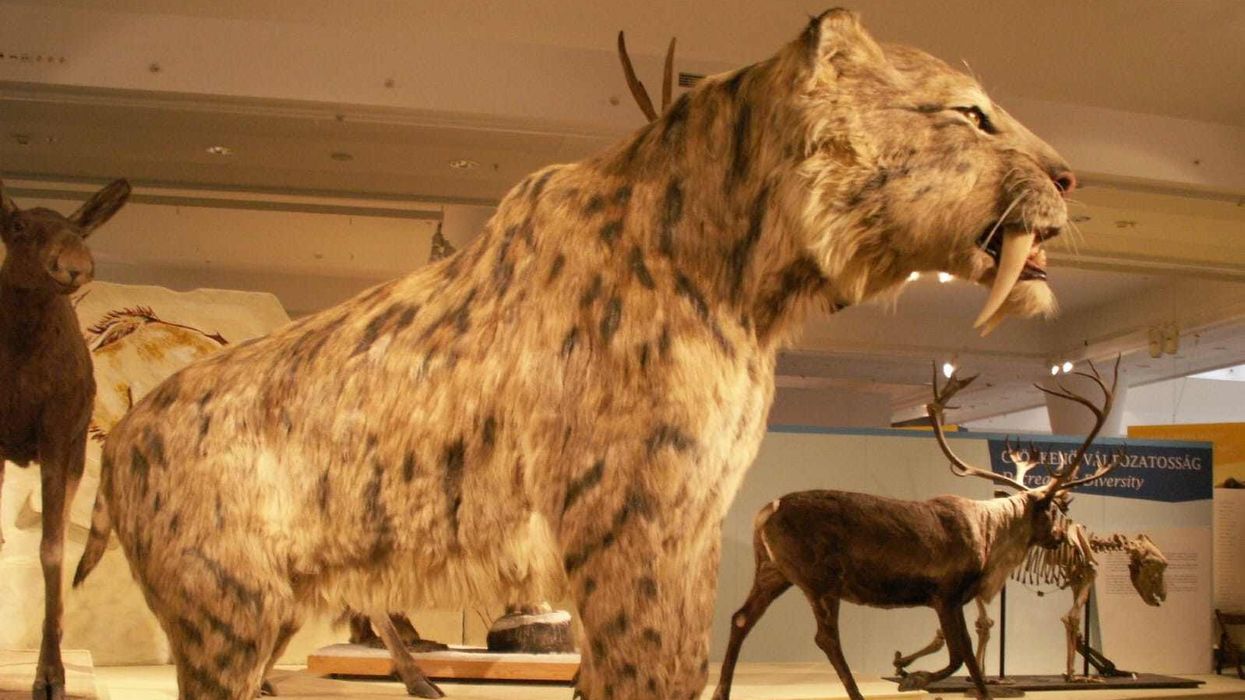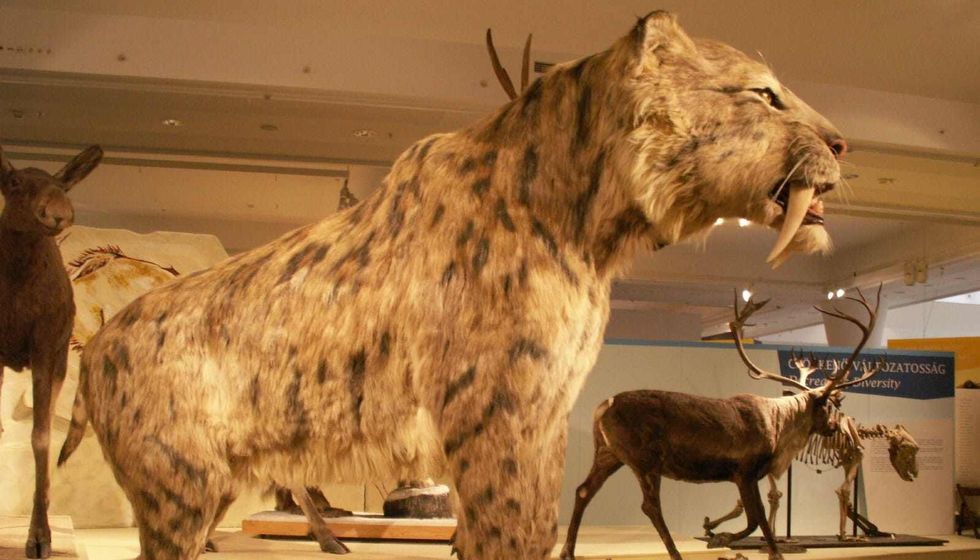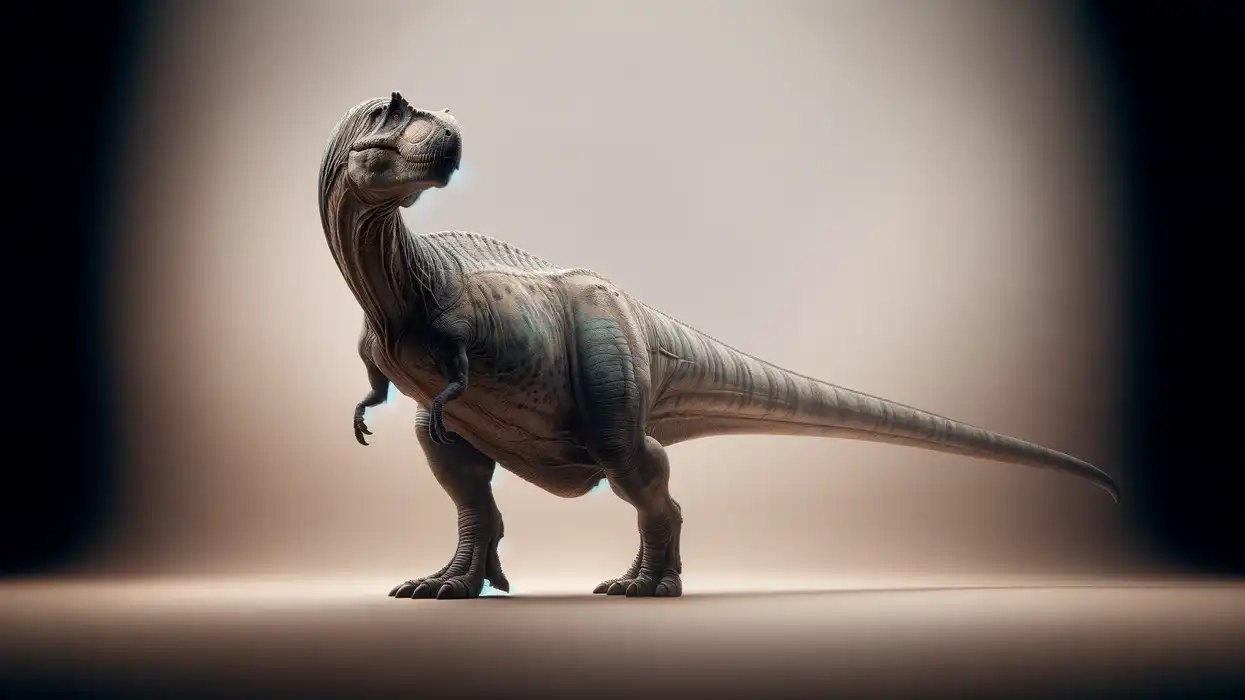Fun Saber-toothed Tiger Facts For Kids

Large prehistoric members of the cat family, saber-toothed tigers are one of the most fascinating and classical mammals known to inhabit the terrains of Earth during the Pleistocene epoch.
With blade-like canines as the defining characteristic and a robust physique resembling modern-day felines, the saber-toothed tigers are recognized worldwide as one of the most iconic organisms of the Ice Age.
Belonging to the extinct genus Smilodon, according to the studies and evidence, these animals were ace predators and primary dwellers in the topography of America. Saber-toothed tiger (Smilodon fatalis) got its name from its prominent pair of saber teeth.
With the changing conditions on earth, and natural as well as human-induced factors, the saber-toothed tigers eventually capitulated, falling short of adaptation which ultimately led to the extinction of these animals.
Analysis of a saber-toothed tiger skeleton reveals that the saber toothed tiger skull resembles that of modern lions. There are three known species of Smilodon that existed in the pre-historic era by the name of Smilodon gracilis, Smilodon populator, and Smilodon fatalis.
In case of roused interest in the saber-toothed tiger (Smilodon fatalis), browse through to peruse and learn some interesting facts about saber-toothed tigers.
After reading these interesting facts on Smilodon big cats, do check our articles on South China tiger and Siberian tiger.
Saber-Toothed Tiger Interesting Facts
What type of animal is a saber-toothed tiger?
Saber-toothed tigers (order carnivora) are mammals of prehistoric times that belong to the genus Smilodon and were native to North America. These organisms are popularly recognized for their razor-edged, long, and protruding canines.
Saber-toothed tigers are known to have existed millions of years ago and are presently categorized as Extinct animals.
Besides their common name, these fascinating members of the Felidae family are also known as saber-toothed cats, saber-toothed tigers, or Smilodon.
Since the existence of the saber-toothed tigers, last known to freely roam the terrains of Earth, can be calculated to date back more than 10,ooo years ago, the majority of study about these animals is based on their fossil remains.
What class of animal does a saber-toothed tiger belong to?
Saber-toothed tiger (Smilodon fatalis) belonged to class Mammalia; that is, organisms that are recognized by the presence of milk-producing mammary glands, anatomically designed for the nourishment of their young ones. They used to live in regions of North America and South America during the Pleistocene epoch. They are believed to be the ancestors of modern lions.
How many saber-toothed tigers are there in the world?
Presently no saber-toothed tiger sightings are possible as they went Extinct about 11,700 years ago. Saber-toothed tigers mainly became the victim of human predatory activities, scarcity of food, and climatic changes.
Where does a saber-toothed tiger live?
Since saber-toothed tigers (order Carnivora) preyed mainly on large herbivores and ruminant organisms, they lived in close proximity to these animals. Therefore according to the evidence, saber-toothed tigers were known to be residents of north and south America and lived near shrubby areas, woodlands, forests, grassland, and plains.
What is a saber-toothed tiger's habitat?
The evidence of the existence of saber-toothed tigers was found to be broadly distributed throughout the landscape of America. Of the three main described species under the genus Smilodon, S. populator was found to have inhabited only in South America. At the same time, S. gracilis and S. fatalis show evidence of residency in North, South, and Central America.
Who do saber-toothed tigers live with?
Saber-tooth tigers (family Felidae) are known to show some similarity in the pattern of their existence with lions. As the members of Panthera leo, saber-tooth tigers show evidence of hunting and moving in packs.
How long does a saber-toothed tiger live?
As this animal went Extinct 10,000 years ago, not much is known about the accurate lifespan of these prehistoric animals. However, the average lifespan of saber-tooth tigers is estimated to lie somewhere between 20 to 40 years.
How do they reproduce?
Though not much is known about the reproduction procedure of saber-tooth tigers, it is assumed to show some similarities with the ones found in big cats.
According to the theories, it is assumed that the female saber-tooth tigers, after selecting the potential mate and undergoing fertilization gave rise to a litter size of about two to three cubs following a gestation period of about eight months.
However, a part of these studies are theoretical, and there is no actual evidence of the breeding procedures.
What is their conservation status?
Saber-toothed tiger Extinct status can be attributed to dire circumstances such as human predation, drastic climatic changes, and scarcity of food which eventually led to saber-toothed tiger ice age Extinction. Saber-toothed tigers, now fall under the category of Extinct organisms as listed by International Union for Conservation of Nature.
Saber-Toothed Tiger Fun Facts
What do saber-toothed tigers look like?
An animal of prehistoric times, according to the fossil evidence, saber-toothed tigers were one of the largest cats and had a robust and sturdy physique with shorter, though bulkier, limbs.
The hind limbs were the shorter of the two sets of limbs. Whereas anatomically, the forelimbs were bulkier, broader, and well developed.
These animals possessed short tails and reduced lumbar regions, along with big neck muscles.
The defining characteristics of saber-toothed tigers were their protruding long and sharp canines and the structure of their jaws.
According to the fossil evidence, these mammals possessed slender but long and blade-like canine teeth that were known to grow as long as about 8-11 in (20-27 cm) long.
Besides the fascinating canine teeth, the fossils of saber-toothed tigers show the presence of incisors and molar teeth, with sufficient gaps that facilitated the clamping of their food with the massive canine teeth.
Since most studies and theories about these organisms were deduced from the bones and no fossil remains of their fur were obtained, not much is known about the color and pattern of the skin structures.

How cute are they?
Saber-toothed tigers are large carnivorous mammals known to be physically sturdy and robust, therefore these large cats can be quite intimidating. However, more than cute, they are assumed to be fierce and formidable with fascinating personalities like those of the other members of the Felidae family.
How do they communicate?
Though not much is known about the communication skills or abilities of saber-toothed tigers, it is assumed that the main communication channels in these organisms were a vocal and olfactory sensation. Saber-toothed tigers are assumed to use their roar for communicating and olfactory capabilities for hunting.
How big is a saber-toothed tiger?
Resembling the modern-day members of the Felidae family, saber-toothed tigers, on the basis of fossil footprinting, are known to range between 79-98 in (200-248 cm). In terms of their length, the saber-toothed tigers outweigh an average grizzly bear.
How fast can a saber-toothed tiger run?
Saber-toothed tigers, a member of family Felidae, are known to take after the other members of this family in their fierceness. Though the accurate speed of these animals is not known, due to their weight and available fossil evidence, the speed of saber-toothed tigers on average is estimated to be about 25-35 mph (40-56 kmph).
How much does a saber-toothed tiger weigh?
Based on saber-toothed tiger fossils, the animals weight is known to range between 120-880 lb (54-399 kg). Smilodon gracilis, the smallest member, was found to be about 120-220 lb (54-99 kg), while the largest member, Smilodon populator, was estimated to possess a weight ranging between 490-880 lb (222-399 kg).
What are the male and female names of the species?
There are no distinct names allotted to the members of these species on the basis of their names. The males are referred to as male saber-toothed tigers while the females are referred to as female saber-toothed tigers.
What would you call a baby saber-toothed tiger?
The babies of saber-toothed tigers are referred to as kittens, offspring, cubs, babies, or juveniles.
What do they eat?
Saber-toothed tigers were recognized to be carnivorous organisms, known to survive by hunting and preying on large herbivores. The diet of these Felidae, on the basis of their fossil remains and their long canines, indicated to have consisted of large prey such as camels, bison, mastodons, woolly mammoths, deer and horses.
Are they dangerous?
Though not much is known about this species, evidence such as the fossil remains of a two million-year-old hominid skull (obtained from the Republic of Georgia) with two large holes matching the size of the canines of saber-toothed tigers, suggests that these animals may have preyed upon our ancestors.
Therefore it can be said that saber-toothed tigers were definitely a dangerous family of wild beasts.
Would they make a good pet?
Saber-toothed tigers were mainly the animals of the wilderness that existed many millions of years ago.
The existence of these organisms was prominent in the era when the techniques to train such wild beasts were not particularly known or recognized. However, even in the modern days, the members of the big cats’ families (particularly the wild members such as lions, tigers and jaguars) are rarely known to take place amongst the human population as pets.
These animals, when tamed, are found largely in reserves or zoos, under the supervision of trained volunteers.
Did you know...
Saber-toothed tigers are known to have possessed massive mouths opening about 120 degrees. This feature was particularly helpful as wider gaps were required to clamp down on their prey given the immense length of their canines.
Owing to their longer calcaneus (the largest bone of the foot) saber-toothed tigers are deduced to be quite good jumpers, despite their enormous weight. In fact, the anatomy of the calcaneus curbs the impact of the weight of these organisms providing them a mechanical advantage.
The estimated era when the saber-tooth tiger inhabited earth can be traced back to as many as 37 million years ago. In fact, the Extinction of these species itself dates back to about 12,000 -10,000 years ago.
According to studies and theories, saber-toothed tigers are assumed to have coexisted with the magnificent and fascinating dire-wolf species.
For quite a span of time, the existence of saber-toothed tigers was assumed by large populations to be just a work of fiction. Particularly until the 19th century, upon the discovery of the first fossils of these animals.
Why did the saber-toothed tiger go extinct?
Based on a number of evidence and studies, the main reasons of saber-toothed tiger Extinction are the high predatory activities of early humans, drastic changes in saber-toothed tiger habitat, climate change during the ice age, and scarcity of food.
Saber-toothed tiger vs. lion
A number of differences can be pointed out and noticed between the extinct organisms saber-tooth tiger vs saber-toothed lion. Here are a few to name:
Saber-tooth tigers are known to be massive cats. According to the preserves available of Smilodon fatalis of the Smilodon community, these prehistoric animals, on the basis of their large limbs and massive physique, were deduced to be much larger in size and build than the Panthera leo species.
The estimated weight of the saber-tooth tiger was found to be as much as 350-661 lb (158-299 kg), while the known weight of lions is about 286-418 lb (129-198 kg).
The defining characteristic of the saber-toothed tigers is the pair of elongated canines. The jaw additionally possessed conical incisors set in curved rows and an enormous jaw gap was also found.
Both these arrangements are unlike the ones found in present day extant lions. The maximum length of the canines in species Smilodon populator was established to be as much as 11 in (27 cm) while that in lions is known to be about 3.9 in (9.9 cm) of length.
Despite the massive physique and long canines, the killing spree of saber-tooth tigers is known to be much weaker than the members of Panthera leo. Mainly due to their weak bites, saber-tooth tigers did not prey on small organisms, which is in complete contrast to the present-day lions.
Here at Kidadl, we have carefully created lots of interesting family-friendly animal facts for everyone to discover! Learn more about some other mammals including lion, or Malayan tiger.
You can even occupy yourself at home by drawing one of our Saber toothed tiger coloring pages.
We Want Your Photos!
More for You
Sources
https://en.wikipedia.org/wiki/Saber-toothed_predator
https://a-z-animals.com/animals/saber-toothed-tiger/
https://www.britannica.com/animal/saber-toothed-cat
Bachelor of Arts specializing in English Literature

Akinwalere OlaleyeBachelor of Arts specializing in English Literature
As a highly motivated, detail-oriented, and energetic individual, Olaleye's expertise lies in administrative and management operations. With extensive knowledge as an Editor and Communications Analyst, Olaleye excels in editing, writing, and media relations. Her commitment to upholding professional ethics and driving organizational growth sets her apart. She has a bachelor's degree in English Literature from the University of Benin, Edo State.
Bachelor of Technology specializing in Information Technology

Smriti ChaudharyBachelor of Technology specializing in Information Technology
Smriti, a student data scientist, and coder, is pursuing her Bachelor of Technology at K.J. Somaiya College of Engineering. She has achieved top rankings in the International English Olympiad, National Spelling Bee, and PSAT/SAT English Section. She is experienced in content creation and editing for various academic institutions.
Disclaimer
1) Kidadl is independent and to make our service free to you the reader we are supported by advertising. We hope you love our recommendations for products and services! What we suggest is selected independently by the Kidadl team. If you purchase using the Buy Now button we may earn a small commission. This does not influence our choices. Prices are correct and items are available at the time the article was published but we cannot guarantee that on the time of reading. Please note that Kidadl is a participant in the Amazon Services LLC Associates Program, an affiliate advertising program designed to provide a means for sites to earn advertising fees by advertising and linking to Amazon. We also link to other websites, but are not responsible for their content.
2) At Kidadl, we strive to recommend the very best activities and events. We will always aim to give you accurate information at the date of publication - however, information does change, so it’s important you do your own research, double-check and make the decision that is right for your family. We recognise that not all activities and ideas are appropriate for all children and families or in all circumstances. Our recommended activities are based on age but these are a guide. We recommend that these ideas are used as inspiration, that ideas are undertaken with appropriate adult supervision, and that each adult uses their own discretion and knowledge of their children to consider the safety and suitability. Kidadl cannot accept liability for the execution of these ideas, and parental supervision is advised at all times, as safety is paramount. Anyone using the information provided by Kidadl does so at their own risk and we can not accept liability if things go wrong.
3) Because we are an educational resource, we have quotes and facts about a range of historical and modern figures. We do not endorse the actions of or rhetoric of all the people included in these collections, but we think they are important for growing minds to learn about under the guidance of parents or guardians.







